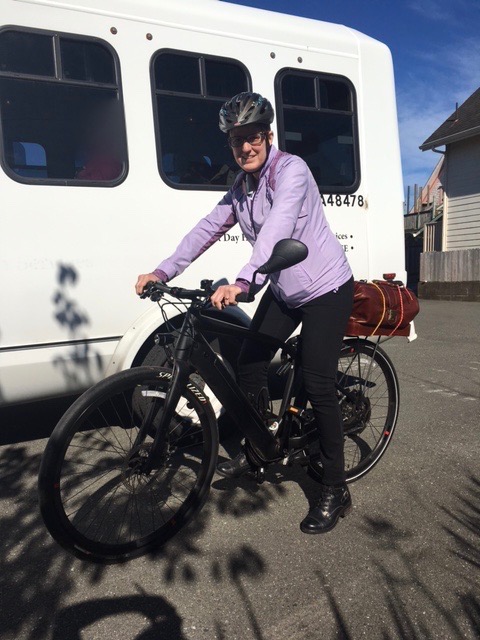
Dr. Heidmann on the way to an apointment.
This sunny Saturday morning, I drove to a couple of house calls in my Northern California rural county, situated behind the redwood curtain. Covering both hospice and my program, Redwood Coast PACE (Program of All-Inclusive Care for the Elderly), the day is brisk with phone calls. I am listening to Bruce Springsteen read his autobiography, Born to Run, which makes the house call miles fly by. Bruce’s story speaks to me about coming from almost nothing and practicing until you start to make something beautiful. He had an imperfect family, no money and little education. This hard scrabble existence is still a real one for so many people, including many of those I serve. And the fact is in small town America, providing healthcare can feel like a hard scrabble existence. People are astoundingly sick, reminding me of my rotations through San Francisco General Hospital, but without the resources of a large tertiary medical center. Lack of resources in our town has allowed (or forced) us to adapt, and to try things that best serve our community. Which brings me back to the house calls.
House calls are old school. And like many things old school are enjoying a retro hip revival. Economically they can make sense (such as potential decrease in expensive emergency room visits and/or hospitalizations), though certainly they are not a high-productivity model for a physician. From the perspective of the person at home, not having to change clothes and find a ride in and avoiding spending 13 hours in an unsettling ER facility is likely a big plus. Mostly though, they are just one tool to provide the best possible care to a vulnerable population.
I have been thinking a lot about best possible care (thank you Ira Byock), as I watch our already broken healthcare system be recklessly dismantled by Senate and Congress. What does it mean to support health in our society, and how can we effectively do no harm in a system that although good-intentioned (for the most part) tends to equate more care as better and forget about the very basics needed for well-being?
Palliative care wraps around an individual and their supports to address suffering and navigate the rabbit hole of healthcare. The PACE model does this as well, with our interdisciplinary team of social work, dietician, nurses, doctor, nurse practitioner, recreational therapist, physical and occupational therapists, care coordinator, home care coordinator, drivers and home and Day Center personal care attendants all in a constant dance with our PACE participants, trying to help them with their goals of living, which can be as varied as “to stay out of a nursing home” to “going back to college”. Everyone on our team is important, but I have to give special kudos to social work. They are often the ones seeing that the basics are in place, as tending to the deeper suffering and goals (including a controlled blood pressure or a pretty hemoglobin A1C level) is going to be tilting at windmills until a roof is over the head (and not caved in, as one did recently), food is available with a way to prepare it, the heat is on or blankets are in place, the dripping mold is reduced, the abusive situation is calmed, and the bills are paid. If you have never seen a PACE social worker go toe to toe with a slum lord, it is a sight to behold.
Sometimes I ride my bike to house calls, with my old school doctor bag (brown leather, I love that thing) strapped on the back. A recent visit to a 90 year old woman from the Azores had her worried about me, saying with concern “Doctor, you are on a bicycle!” For her, this was a sign of poverty. I reassured her I enjoyed riding. And admittedly my bike is a pretty sweet ride. I have made dozens of calls to her house, often leaving with crocheted booties and the lingering aroma of her cooking in my olfactory lobe. She died last week, with hospice joining our team to give best possible care. I can tell you she felt cared for as a person right until the end.
With all of our technologies, we seem to have lost track of what it means to promote well being in healthcare. I feel lucky to have found myself in a role that tends to this, and that makes me feel content as a physician. I get to meet people where they are, figuratively and sometimes literally. I always try to understand their goals, as people, not patients. I have a team to offer the expertise I do not have. I work in a model of care that has served elders with an holistic approach for 45 years. This model really should be extended to everyone with chronic medical conditions, mental illness, and complicated medical issues to navigate. The future of such innovation is pretty murky right now. Those of us who are passionate about geriatrics, palliative and end of life care have to keep fighting the good fight.
Bruce Springsteen wrote a song “We Take Care of Our Own.” It points out the merciful and loving possibility we hold in our nation which might find conflict in blind patriotism or trust in the powers that be. What does this have to do with healthcare and my day of house calls? Just this: we have a responsibility to the people we serve, to our own well-being as healers and as people of relative power in our society. We have a voice, and we should use it. Also relevant: never underestimate the value of a good book on tape or some solid rock and roll music to take the sting out of a day on call, in the field.
by: Jennifer Heidmann, MD, is a physician who blogs regularly at redwoodsandrunning



